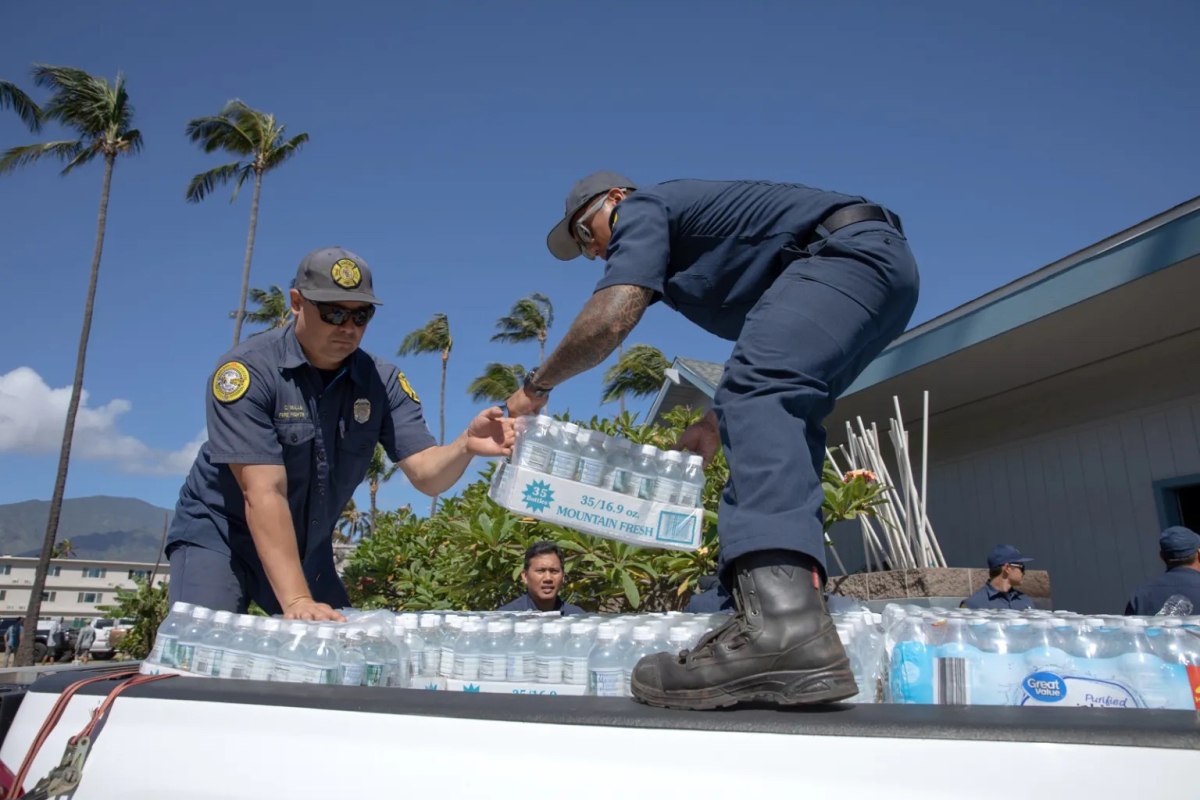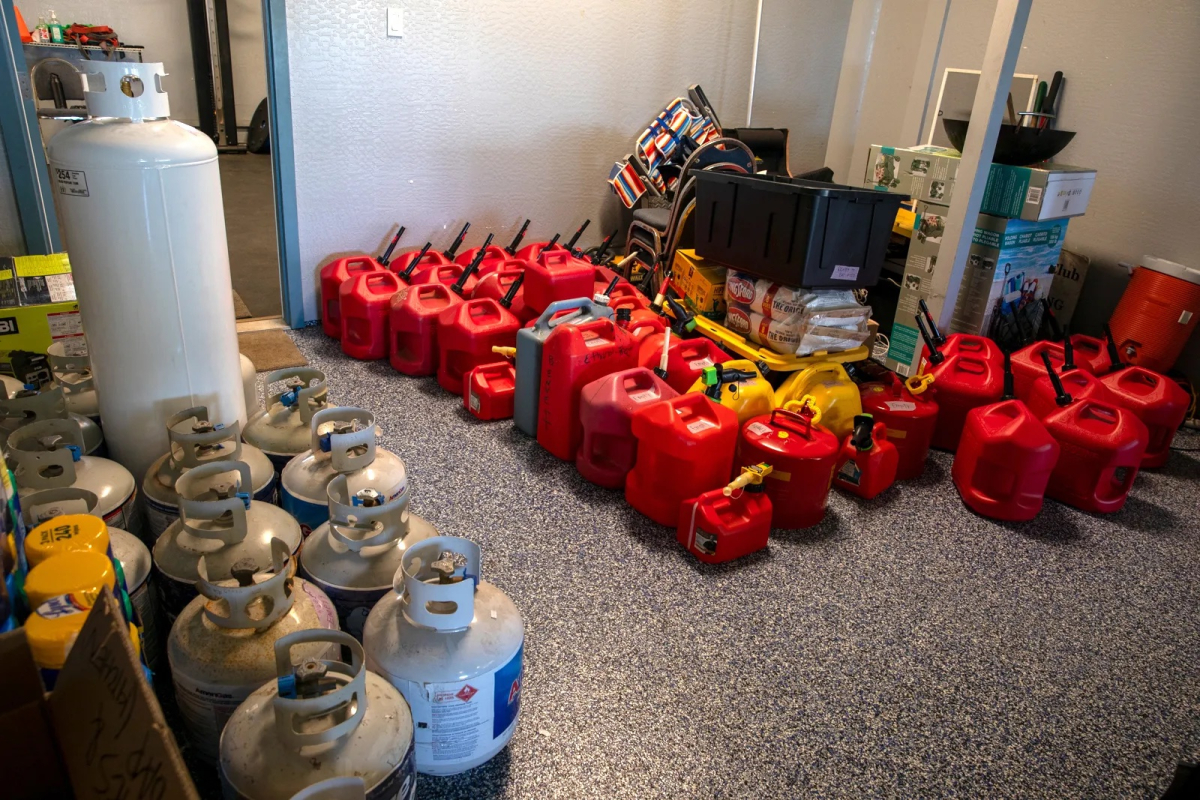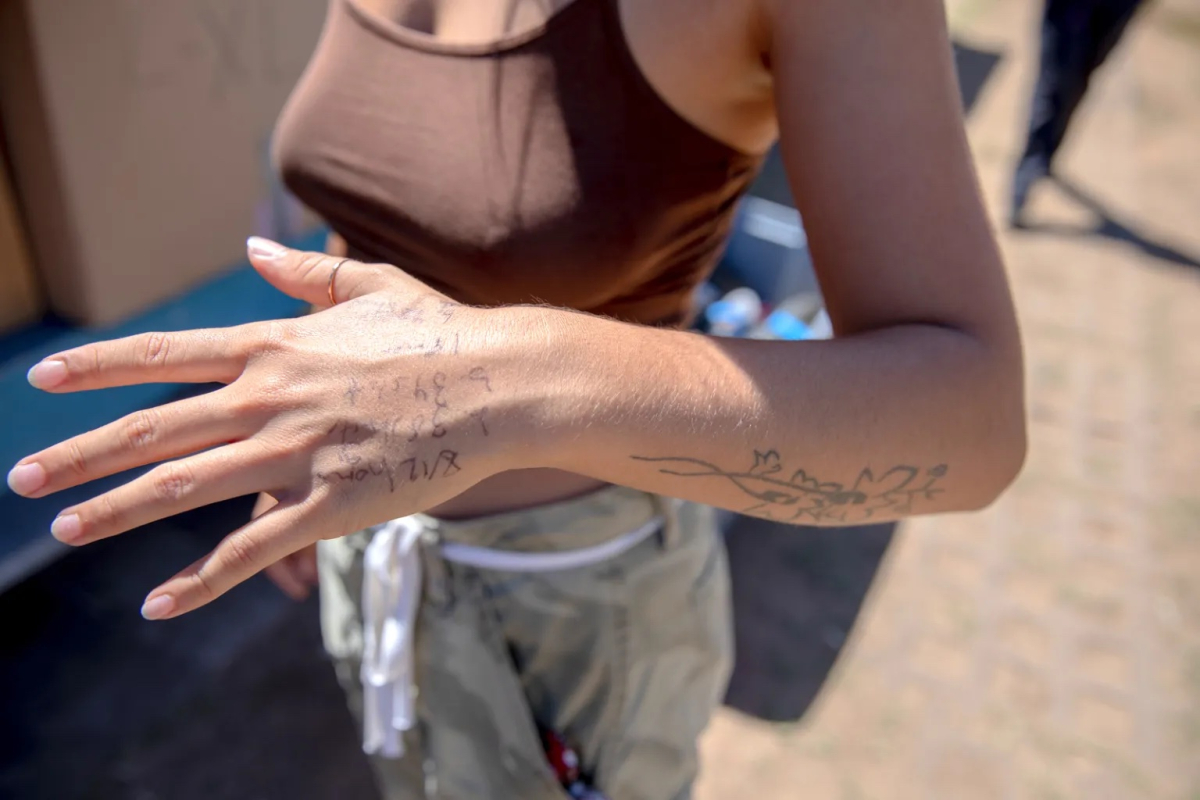Support strong Canadian climate journalism for 2025
This story was originally published by Grist and appears here as part of the Climate Desk collaboration.
Inside the Hawaiian Canoe Club hale, or house, volunteers set out boxes filled with donated diapers, toiletries and clothes for families to pick up. Against a backdrop of the bright blue waters of Kahului Harbor and the cloud-covered West Maui mountains, they filled trucks with gasoline cans, propane tanks and coolers of ice behind a sign reading, “Donate — We have convoy to Lahaina.”
A mile away, outside the entrance to the shelter at War Memorial Gym, a steady stream of cars pulled up along pallets stacked high with supplies. Drivers called out through their windows how many people they were delivering to, their ages and needs. An assembly line of volunteers led by Kanaka Maoli, or Native Hawaiians, stuffed each vehicle with donations before moving on to the next.
And on a corner lot in a neighbourhood near Maui High School, a Hawaiian family turned their front yard into a distribution centre, collecting necessities for the dozens of people crammed into the homes of family or friends or living in their cars nearby. The family had taken to affectionately calling a large trailer in front of the house, where people could sift through carefully organized boxes of clothing, the “walk-in closet.”
Across Maui, community hubs like these have cropped up with dizzying speed in the days since wildfires swept through the island on Aug. 8, killing at least 99 (with the death toll expected to rise), destroying more than 2,200 buildings, and displacing thousands. They are led by the community, and grounded in the deeply held Hawaiian values of caring for and sharing with one another. But they are also driven by a growing concern that the people still in their homes around Lahaina and displaced across Maui are not getting enough help from authorities.

“A lot of people are mobilizing,” Leo Nahenahemailani Smith, one of the volunteers at the canoe club, said Sunday. “With aloha, you give whether people ask or not. It’s in our nature.”
U.S. President Joe Biden, noting that the wildfire was the deadliest the nation has seen in more than a century, vowed that the people of Maui will get all the help they need. “Every asset, every asset they need will be there for them, and we’ll be there on Maui as long as it takes, as long as it takes and I mean that sincerely.”
But since the fires ravaged West Maui, much of the burden of helping survivors has fallen on local volunteers, with government assistance noticeably absent in some places.
On Sunday, volunteers arrived at the canoe club at 7:30 a.m. to put out boxes of donations. Others made calls to area shelters to see what they needed, then dispatched drivers with supplies. Most had been working for five days straight, sometimes 12-hour shifts. A few had set to work after helping neighbours and relatives fend off the fires that burned upcountry Maui.
A steady flow of people passed through the hale dropping off donations. A family from Hana, a two-hour drive away, stopped by on their way to Costco, asking what they could provide. They returned a couple hours later with propane and ice. A young man offered some two-way radios. A group of firefighters from Honolulu filled a truck with cases of water before heading off to a shelter. A couple with a baby strapped into the backseat of their car dropped off gas cans they’d filled themselves.

Others came seeking items for themselves or for those they were caring for. A woman asked about baby wipes, which she hadn’t been able to find. A man who lost his home picked out a few shirts and shorts. A couple whose house had been spared in the upcountry fires filled their truck with supplies for their neighbours, all of whom had lost their homes.
Sunday afternoon, volunteers cooked and packed up hot meals before a convoy of pickup trucks arrived to transport food, gasoline, propane, and coolers of ice to Lahaina and the surrounding areas.
It is unclear how many people remain in Lahaina, but two sources estimated the number might exceed 1,000. Access to West Maui remains restricted, and the few entry points have at times been chaotic and tense. At first, residents were told they would not be allowed back if they left, so many chose to stay. Some had no other choice.
“They have nowhere else to go,” said Tiare Lawrence, one of the volunteers at the Hawaiian Canoe Club. Many of her relatives lost their houses, including one that had been in the family for four generations.
Others have been afraid to leave their homes for fear of looters and thieves. “A lot of people are hunkering down just to protect their homes,” Lawrence said.
Supplies are being taken into West Maui by people who can prove they live there or who have special passes. Those without them are finding workarounds. In the first days of the recovery, brigades of boats and jet skis ferried supplies.
So many deliveries of clothes and household goods have arrived that some are being turned away. But with power still out in portions of West Maui, volunteers have shifted their focus to the supplies needed to sustain residents in the long term, like fuel for generators, ice, solar lamps, batteries, and water. West Maui residents have been warned against drinking the water even if it’s boiled because of wildfire contaminants. “That’s the hardest stuff to find right now, and it’s the stuff we most need,” said Chase Pico, a volunteer at the distribution site outside the War Memorial shelter.


Hubs inside the restricted zone offer food, water, and other essentials, but volunteers worry they are not reaching people who can’t leave their homes or who live in more remote areas. They’re driving on back roads, going neighbourhood by neighbourhood to find people who aren’t being reached by state and federal authorities. Many told Grist they’re not seeing any indications of government aid around Lahaina beyond the disaster area.
“I haven’t seen people in uniform, only locals in trucks [making deliveries],” said Cheyanne Kaawa, who has spent days shuttling supplies into Lahaina and couldn't understand why Gov. Josh Green had not yet requested U.S. military assistance. The Hawaii National Guard is on the ground on Maui, but the governor has not yet requested active-duty troops. The governor’s office did not return two requests for comment.
With multiple storms forecast to hit the area this week, Kaawa worried that the prolonged wait is endangering survivors, especially ones who lost their roofs. “Today is day eight, three fires are still going, our water is contaminated, and a lot of people still have no power or ways to communicate,” she said. “Vulnerable homes and lives that were spared in the first fire might not make it through the next storm.”
Paul Kaʻuhane Luʻuwai, head coach of the canoe club and one of the convoy drivers who had made multiple delivery trips, said on Sunday that he also had not seen anyone from FEMA in the neighbourhoods. His family lost seven houses in the fire. “I want to know where the hell is the government,” he said. “Yes, they're looking for remains, but it’s been five days. Where are they?”
A FEMA spokesperson said that the agency was providing the services that the state had requested of them, including registering residents at shelters so that they can receive aid, and that it has urban search and rescue teams in Lahaina focused on the disaster site.
Asked why the Red Cross had not yet gone into the restricted area to distribute aid and check on residents, a spokesperson for the agency, which is managing several shelters, also said they needed permission from state officials to do so.

The need for aid extends well beyond those who remain in Lahaina. Around 2,100 people entered shelters after the fire, but countless evacuees remain dispersed across the island, staying with loved ones, in their cars, or even in tents in yards. Those who are hosting them are straining to support the displaced in addition to their own families.
Kekane and Josh Kuloloio set up a distribution centre in their front yard after realizing that many people had taken shelter in homes and in parked cars around their neighbourhood. Kekane said she knew of one house hosting 24 people. They'd also met a man who was living in his car with his son.
The situation has put stress on the Kuloloios, too, who have five children, two of them younger than 3. It’s been hard to find diapers because of the concentrated demand. “It's an island-wide crisis,” said Josh Kuloloio.
He’s also frustrated by how difficult the government has made it to bring help or even volunteer at official shelters.

“FEMA knows nothing about our culture of taking care of everybody, of nobody left behind,” he said. “They’re butting up against who we are.”
Similar frustrations came up at the canoe club. A woman appeared with boxes of homemade fruit cups that she tried to donate at the War Memorial Gym shelter but had been turned away. “The aunties in there are tired of eating canned food, but they won’t even let me give them fruit,” she said.

Despite restrictions that many residents say limit them from caring for their own, community volunteers continue finding ways to offer whatever solace they can. When a little boy arrived at the canoe club missing the toy trucks he’d lost in the fire, volunteers rummaged through donations until they found a Hot Wheels car for him.
“It's just a little bit of normalcy, a tad of comfort,” said Tahina Kinores, one of the co-ordinators. That evening, she stayed three hours past when the hub was scheduled to close so that families who didn’t want to be seen asking for help could come get supplies in private.
Around 8:30 p.m., Kinores and some close friends who had been there for 13 hours moved all the boxes back into the hale. Someone turned on a reggae song, they opened beers, and they swayed to the music. It was only a brief reprieve. The next morning, they’d do it all over again.
Grist senior staff writer Anita Hofschneider contributed reporting to this story.
This story has been updated after FEMA clarified that it has urban search and rescue teams at the disaster site.





Comments